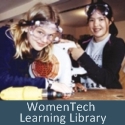Ask Donna: New Video Blog and Contest Winners
In this video blog, I answer a great question from the first of the 3 winners of last month’s *Ask Donna* Video Blog Contest:
First of 3 Winning Questions: “How can I overcome the machismo? I am in beautiful South Texas! We have a very strong Hispanic culture in our area. I have a lot of young ladies who come to my demo-days and say this is what I want to do, but then they go home and tell Mom and Dad, Grandma and Grandpa, and get told women don’t do that type of work and that’s the end of it. Out of 2,500 ladies I have talked to, only 1 has completed my millwright program. She graduates this Friday and will be making close to $32 an hour! She just turned 21.” ~ Dan Anderson, Faculty, Millwright Industrial Maintenance Mechanic, Del Mar College, Corpus Christi, Texas
Want to hear the specific recruitment strategies I recommend for overcoming recruitment roadblocks like this? You won’t want to miss this video!
Watch my video blog to learn how a few changes to existing recruitment events can make all the different in recruiting female students to STEM and CTE programs such as Dan’s millwright program.
In this video, I also congratulate all 3 winners of my *Ask Donna* Video Blog Contest who asked the 3 best questions:
- Dan Anderson, Faculty, Millwright Industrial Maintenance Mechanic, Del Mar College, Corpus Christi, Texas
- Vicki Mazur, Teacher, Math/Computer Science, Classical Academy Online, San Diego, California
- George Karnbauer, Instructor, Computer Networking, Forbes Road – Career & Technology Center, Pennsylvania
Congratulations to all 3 winners of our Unlimited Potential female role model posters! I can’t wait to answer the questions from our next 2 winners in my next video blogs.
Talk with Donna 1-on-1 in a Women in STEM & CTE More Information Session: Sign up for a free call to talk with Donna about your college’s STEM/CTE programs and specific challenges.
The *Ask Donna* WomenTech Educators Video Blog: Have questions about how you can see more women and girls in your STEM/CTE courses? Need help overcoming a recruitment or retention challenge specific to your program and school? Now is your chance to get your question answered in a personal video from Donna Milgram—IWITTS Executive Director and developer of the WomenTech Educators Training System—in this new monthly video blog. Answering questions is Donna’s favorite part of providing professional development to help educators move the needle for women in STEM and CTE.
Want Donna to answer your question in the next *Ask Donna* video blog? Donna’s coaching is usually limited to WomenTech Educators Training school teams, so don’t miss this opportunity to *Ask Donna* your questions on broadening participation.
Ask Donna – Submit a Question Now
Stay tuned for a new *Ask Donna* video blog each month! Next month I’ll be answering Question #2 from the *Ask Donna* contest.

 I’m so happy to share with you that IWITTS will receive an Advanced Technological Education (ATE) grant from the National Science Foundation to help increase enrollment and retention of women in community college STEM courses!
I’m so happy to share with you that IWITTS will receive an Advanced Technological Education (ATE) grant from the National Science Foundation to help increase enrollment and retention of women in community college STEM courses! Just last week I conducted a WomenTech Educators Training for a very engaged group of IT instructors from across the state of California (and half of the participants were male – yay!). Yet, many of my recruitment and retention secrets were completely new information to them. Why are our secrets still secrets in 2014? During the break, a male IT instructor – who also works in industry – said to me, “I now understand the differences between female and male learning styles, wow, what a difference that makes to me both as a teacher and in my workplace.” My goal for the next 20 years is for our recruitment and retention secrets to not to be secrets anymore. We must expand our work and scale up so that our recruitment and retention secrets are not just held by separate and special programs for women and girls in STEM but instead are the domain of the mainstream education system at all school levels.
Just last week I conducted a WomenTech Educators Training for a very engaged group of IT instructors from across the state of California (and half of the participants were male – yay!). Yet, many of my recruitment and retention secrets were completely new information to them. Why are our secrets still secrets in 2014? During the break, a male IT instructor – who also works in industry – said to me, “I now understand the differences between female and male learning styles, wow, what a difference that makes to me both as a teacher and in my workplace.” My goal for the next 20 years is for our recruitment and retention secrets to not to be secrets anymore. We must expand our work and scale up so that our recruitment and retention secrets are not just held by separate and special programs for women and girls in STEM but instead are the domain of the mainstream education system at all school levels. I’m grateful to the IWITTS community – thousands of educators from around the country – who have partnered with us and worked with each other to implement these proven strategies in their classrooms, programs, districts, regions and states. From adjunct instructors to college presidents, and counselors, advisors, administrators, and many others, I’m continually inspired by the dedication of educators who care deeply about ensuring that female students have unlimited potential to pursue rewarding, fulfilling careers in STEM. It’s up to us to ensure that the secrets to recruiting and retaining women (and men) in STEM won’t be secrets anymore.
I’m grateful to the IWITTS community – thousands of educators from around the country – who have partnered with us and worked with each other to implement these proven strategies in their classrooms, programs, districts, regions and states. From adjunct instructors to college presidents, and counselors, advisors, administrators, and many others, I’m continually inspired by the dedication of educators who care deeply about ensuring that female students have unlimited potential to pursue rewarding, fulfilling careers in STEM. It’s up to us to ensure that the secrets to recruiting and retaining women (and men) in STEM won’t be secrets anymore.






Recent Comments